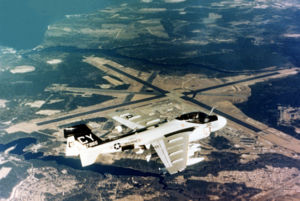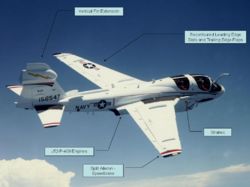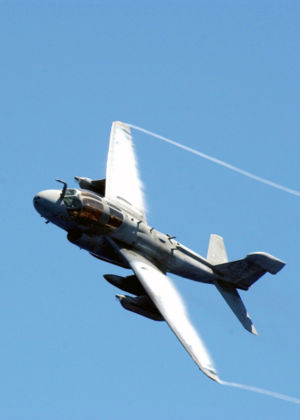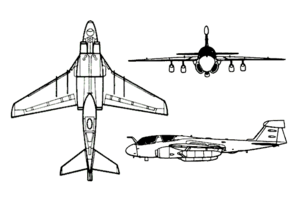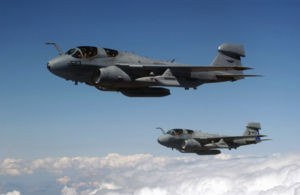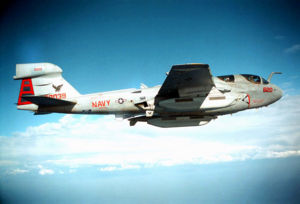PlaneSpottingWorld welcomes all new members! Please gives your ideas at the Terminal.
EA-6B Prowler
| EA-6B Prowler | |
|---|---|
| A U.S. Navy EA-6B Prowler | |
| Type | Electronic attack |
| Manufacturer | Grumman |
| Maiden flight | 25 May 1968 |
| Introduced | July 1971 |
| Primary users | United States Navy United States Marine Corps |
| Developed from | A-6 Intruder |
The EA-6B Prowler is a twin-engine, mid-wing aircraft manufactured by Northrop Grumman Aerospace Corporation as a modification of the basic A-6 Intruder airframe.
Contents
Mission
Designed for carrier and advanced base operations, the Prowler is a fully integrated electronic warfare system combining long-range, all-weather capabilities with advanced electronic countermeasures. A forward equipment bay and pod-shaped faring on the vertical fin house the additional avionics equipment. It is the United States Navy's and the United States Marine Corps's primary electronic warfare aircraft. The primary mission of the aircraft is to support strike aircraft and ground troops by interrupting enemy electronic activity and obtaining tactical electronic intelligence within a combat area.
Since the retirement of the EF-111A Raven in 1995, it is one of the primary aerial radar jammers in the DOD arsenal. It has been utilized in practically every US combat operation and is frequently flown in support of the US Air Force. The increased usage has shortened the airframes' lifetimes and the USN's aircraft are slated to be replaced by the EA-18G Growler.
Development
The Prowler has a crew of four, a pilot and three Electronic Counter-measures Officers (known as ECMOs). Powered by two non-afterburning Pratt & Whitney J52-P408 turbojet engines, it is capable of speeds of up to 950 km/h with a range of 1,840 kilometers. Since EW operations are very demanding, the Prowler is a high-maintenance aircraft and also undergoes more frequent equipment upgrades than any other aircraft in the Navy.
Design particulars include the refueling probe being asymmetrical, appearing bent to the right; it contains an antenna near its root. The canopy has a shading of gold not for sunlight but to protect the crew against the radio emissions that the electronic warfare equipment produces.
Although designed as an electronic escort and command and control platform for strike missions, the EA-6B is also capable of attacking surface targets on its own, especially radars, SAM launchers, and other enemy defenses. The AGM-88 HARM (High-speed Anti-Radiation Missile) is the main offensive strike weapon of the Prowler. In addition, the aircraft is highly capable of conducting electronic intelligence (ELINT) collection.
An earlier EA-6A "Electric Intruder" was developed during the Vietnam War. Basically a straightforward conversion of the standard two-seat A-6 airframe fitted with EW equipment, it was essentially an interim aircraft used only by a few USMC squadrons.
The much more advanced and substantially redesigned EA-6B first flew on May 25, 1968 and entered service with VAQ-132 'Scorpions' in July 1971. The first combat mission of the EA-6B was flown in Vietnam by Commander Everett F. "Rosie" Rollins, the squadron commanding officer.[citation needed] The squadron deployed in April of 1972 and returned in April of 1973.
Advanced Capability EA-6B (ADVCAP)
The Advanced Capability EA-6B Prowler (ADVCAP) was a development program initiated to improve the flying qualities of the EA-6B and to upgrade the avionics and electronic warfare systems. The intention was to modify all EA-6B's into the ADVCAP configuration, however the program was removed from the Fiscal Year 1995 budget due to financial pressure from competing Department of Defense acquisition programs.
The ADVCAP development program was initiated in the late 1980's and was broken into to three distinct phases: Full-Scale Development (FSD), Vehicle Enhancement Program (VEP) and the Avionics Improvement Program (AIP).
FSD served primarily to evaluate the new AN/ALQ-149 Electronic Warfare System. The program utilized a slightly modified EA-6B to house the new system.
The VEP added numerous changes to the aircraft to address deficiencies with the original EA-6B flying qualities, particularly lateral-directional problems that exacerbated recovery from out-of-control flight. Bureau Number 158542 was used. Changes included:
- Leading edge strakes (to improve directional stability)
- Fin pod extension (to improve directional stability)
- Ailerons (to improve slow speed lateral control)
- Recontoured leading edge slats and trailing edge flaps (to compensate for an increase in gross weight)
- Two additional wing stations on the outer wing panel (for jamming pods only)
- New J52-P-409 engines (increased thrust of 2000 lbf (8.9 kN) engine)
- New digital Standard Automatic Flight Control System (SAFCS)
The added modifications increased the aircraft gross weight approximately 2000 lb (900 kg) and shifted the center of gravity 3% MAC aft of the baseline EA-6B. When operating at sustained high angles-of-attack, fuel migration would cause additional shifts in CG with the result that the aircraft had slightly negative longitudinal static stability. Results of flight tests of the new configuration showed greatly improved flying qualities and the rearward shift of the CG had minimal impact.
The AIP prototype (bureau number 158547) represented the final ADVCAP configuration, incorporating all of the FSD and VEP modifications plus a completely new avionics suite which added multi-function displays to all crew positions, a head-up display for the pilot, and dual GPS/INS naviagtion systems. The initial joint test phase between the contractor and the US Navy test pilots completed successfully with few deficiencies.
Current operations
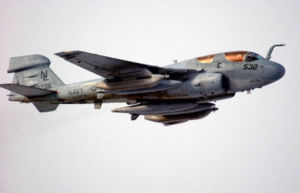
About 125 Prowlers remain today, divided between 12 Navy, 4 Marine, and 3 joint Navy-Air Force "Expeditionary" squadrons. A JCS staff study recommended that the EF-111 Raven be retired to reduce Type/Model/Series aircraft dedicated to the same mission, which led to an OSD Program Decision Memorandum (PDM) to establish 3 "expeditionary" Prowler squadrons composed of Navy and USAF personnel to meet the needs of the Air Force. The Prowler is unaffectionately known as the "Queer", a nickname derived from the "Q" in Prowler squadrons' "VAQ" designation as opposed to the A-6 Intruder squadrons' "VA" designation, thus making the Prowler a "Queer A-6."
Though it remains in service today, the Navy EA-6B Prowler community is slated to be begin transitioning in 2009 to the EA-18G Growler, a new electronic warfareAirborne Electronic Attack] derivative of the F/A-18F Super Hornet. All but one active duty Navy EA-6B squadrons are based at Naval Air Station (NAS) Whidbey Island, located in the northwest corner of the state of Washington. VAQ-136 is stationed at Naval Air Facility Atsugi, Japan, as part of Carrier Air Wing 5, the forward deployed air wing that deploys aboard USS Kitty Hawk and VAQ-209, a Navy Reserve squadron, is stationed at NAF Washington, DC. Marine EA-6B squadrons are located at Cherry Point, North Carolina.
Units using the EA-6B
USN squadrons
- VAQ-128 Phoenix (disestablished 2004)
- VAQ-129 Vikings
- VAQ-130 Zappers
- VAQ-131 Lancers
- VAQ-132 Scorpions
- VAQ-133 Wizards
- VAQ-134 Garudas
- VAQ-135 Black Ravens
- VAQ-136 Gauntlets
- VAQ-137 Rooks
- VAQ-138 Yellow Jackets
- VAQ-139 Cougars
- VAQ-140 Patriots
- VAQ-141 Shadowhawks
- VAQ-142 Grey Wolves
- VAQ-209 Star Warriors
USMC squadrons
Incidents
- It was an USMC EA-6B Prowler that caused the Cavalese cable-car disaster in 1998, cutting the cables of a ski-lift in Italy and killing 20.
- In 1981 an EA-6B crashed onto the flight deck of the USS Nimitz and caused a blaze, killing the flight crew and several deck personnel.
- The latest incident occurred March 3, 2006 near Pendleton, Oregon, USA.
- Despite the fact that to date no Prowler has ever been lost in combat, about forty were destroyed in various accidents.
Specifications (EA-6B)
Data from US Navy Fact File[1]
General characteristics
- Crew: four (one pilot, three electronic countermeasures officers)
- Length: 59 ft 10 in (17.7 m)
- Wingspan: 53 ft (15.9 m)
- Height: 16 ft 8 in (4.9 m)
- Wing area: 528.9 ft² (49.1 m²)
- Empty weight: 34,000 lb (15,450 kg)
- Loaded weight: lb (kg)
- Useful load: lb (kg)
- Max takeoff weight: 61,500 lb (27,500 kg)
- Powerplant: 2× Pratt & Whitney J52-P408A turbojet, 10,400 lbf (46 kN) each
Performance
- Never exceed speed: knots (mph, km/h)
- Maximum speed: 575 mph (920 km/h)
- Cruise speed: knots (mph, km/h)
- Stall speed: knots (mph, km/h)
- Range: 2,022 mi (tanks kept) 2,400 mi (tanks dropped) (3,254 km 3,861 km)
- Service ceiling: 37,600 ft (11,500 m)
- Rate of climb: 12,900 ft/min (65 m/s)
- Wing loading: 116 lb/ft² (560 kg/m²)
- Thrust/weight: 0.34
Armament
- Up to 4 AGM-88 HARM antiradar missiles
- Up to 5 ALQ-99 Tactical Jamming System (TJS) external pods
- Up to 5 300 gallon external drop tanks
Avionics
- ALQ-99 on board receiver (OBS), ALQ-99 pod mounted jamming system (TJS)
- USQ-113 communications jamming system
References
- ↑ EA-6B Prowler electronic warfare aircraft. US Navy Fact File (August 5, 2003).
External links
- Navy.mil - Standard Aircraft Characteristics: EA-6B
- Aviation Safety Consulting Services - EA-6B Gondola Mishap, Cavalese, Italy, February 3, 1998
- East Oregonian News - Navy pilots honor philanthropic locals
- Grumman EA-6B Prowler - NASA Langley, discussion of ADCAP VEP and cooling modifications.
- EA-6B Prowler at GlobalSecurity.org
Related content
Related development
Comparable aircraft
Related lists
Template:Active military aircraft of the United States
Lists relating to aviation | |
|---|---|
| General | Timeline of aviation · Aircraft · Aircraft manufacturers · Aircraft engines · Aircraft engine manufacturers · Airports · Airlines |
| Military | Air forces · Aircraft weapons · Missiles · Unmanned aerial vehicles (UAVs) · Experimental aircraft |
| Notable incidents and accidents | Military aviation · Airliners · General aviation · Famous aviation-related deaths |
| Records | Flight airspeed record · Flight distance record · Flight altitude record · Flight endurance record · Most produced aircraft |
de:Grumman A-6#EA-6B_Prowler
fr:Grumman EA-6 Prowler
it:Grumman EA-6B Prowler
sv:Northrop Grumman EA-6B Prowler
zh:EA-6徘徊者式电子反制机
